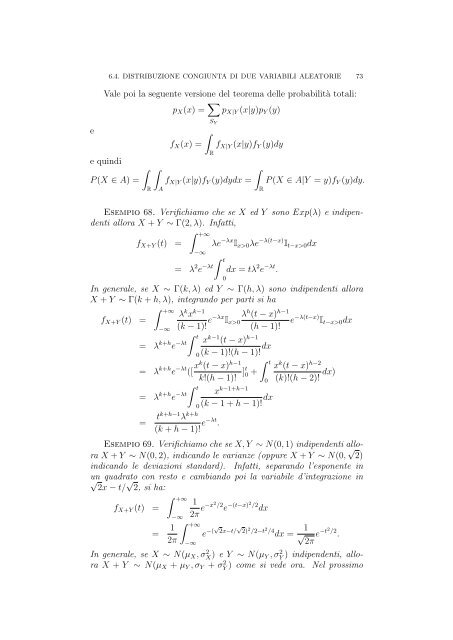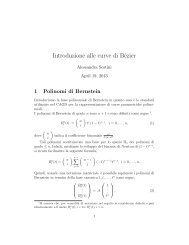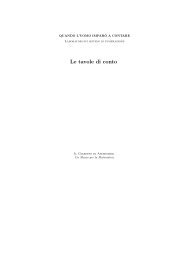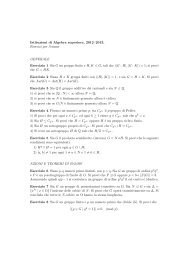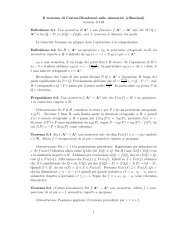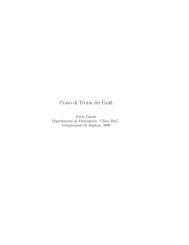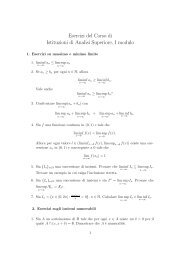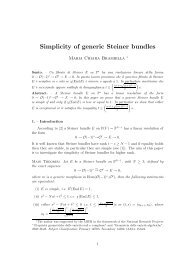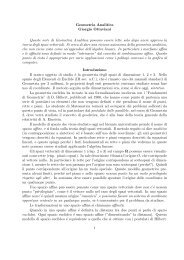parte I.pdf (relativa corso ingegneria)
parte I.pdf (relativa corso ingegneria)
parte I.pdf (relativa corso ingegneria)
You also want an ePaper? Increase the reach of your titles
YUMPU automatically turns print PDFs into web optimized ePapers that Google loves.
6.4. DISTRIBUZIONE CONGIUNTA DI DUE VARIABILI ALEATORIE 73Vale poi la seguente versione del teorema delle probabilità totali:p X (x) = ∑ p X|Y (x|y)p Y (y)S Yee quindi∫P (X ∈ A) =R∫A∫f X (x) =Rf X|Y (x|y)f Y (y)dy∫f X|Y (x|y)f Y (y)dydx =RP (X ∈ A|Y = y)f Y (y)dy.Esempio 68. Verifichiamo che se X ed Y sono Exp(λ) e indipendentiallora X + Y ∼ Γ(2, λ). Infatti,f X+Y (t) =∫ +∞−∞λe −λx I x>0 λe −λ(t−x) I t−x>0 dx= λ 2 e −λt ∫ t0dx = tλ 2 e −λt .In generale, se X ∼ Γ(k, λ) ed Y ∼ Γ(h, λ) sono indipendenti alloraX + Y ∼ Γ(k + h, λ), integrando per parti si haf X+Y (t) =∫ +∞−∞λ k x k−1 λ h (t − x) h−1(k − 1)! e−λx I x>0 e −λ(t−x) I t−x>0 dx(h − 1)!∫ t= λ k+h e −λt x k−1 (t − x) h−10 (k − 1)!(h − 1)! dx= λ k+h e −λt ([ xk (t − x) h−1 ∫ t] t 0 +k!(h − 1)!x k−1+h−1∫ t= λ k+h e −λt 0 (k − 1 + h − 1)! dx= tk+h−1 λ k+h(k + h − 1)! e−λt .0x k (t − x) h−2(k)!(h − 2)! dx)Esempio 69. Verifichiamo che se X, Y ∼ N(0, 1) indipendenti alloraX + Y ∼ N(0, 2), indicando le varianze (oppure X + Y ∼ N(0, √ 2)indicando le deviazioni standard). Infatti, separando l’esponente inun √ quadrato √ con resto e cambiando poi la variabile d’integrazione in2x − t/ 2, si ha:f X+Y (t) =∫ +∞= 12π−∞∫ +∞1 /22π e−x2 e −(t−x)2 /2 dx−∞e −(√ 2x−t/ √ 2) 2 /2−t 2 /4 dx = 1 √2πe −t2 /2 .In generale, se X ∼ N(µ X , σX 2 ) e Y ∼ N(µ Y , σY 2 ) indipendenti, alloraX + Y ∼ N(µ X + µ Y , σ Y + σY 2 ) come si vede ora. Nel prossimo


